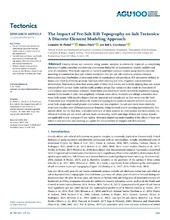The Impact of Pre‐Salt Rift Topography on Salt Tectonics: A Discrete‐Element Modeling Approach
Peer reviewed, Journal article
Published version

Åpne
Permanent lenke
https://hdl.handle.net/1956/21943Utgivelsesdato
2019Metadata
Vis full innførselSamlinger
- Department of Earth Science [1103]
Originalversjon
https://doi.org/10.1029/2018tc005174Sammendrag
Gravity‐driven salt tectonics along passive margins is commonly depicted as comprising domains of updip extension and downdip contraction linked by an intermediate, broadly undeformed zone of translation. This study expands on recently published physical models using discrete‐element modeling to demonstrate how salt‐related translation over pre‐salt rift structures produce complex deformation and distribution of structural styles in translational salt provinces. Rift geometries defined by horsts and tilted fault‐blocks generate base‐salt relief affecting salt flow, diapirism and overburden deformation. Models show how flow across pairs of tilted fault‐blocks and variably‐dipping base‐salt ramps associated with pre‐salt faults and footwalls produce abrupt flux variations that result in alternation of contractional and extensional domains. Translation over tilted fault‐blocks defined by basinward‐dipping normal faults results in wide, low amplitude inflation zones above footwalls and abrupt subsidence over steep fault‐scarps, with reactive diapirs that are squeezed and extrude salt as they move over the fault. Translation over tilted‐blocks defined by landward‐dipping faults produces narrow inflation zones over steep fault‐scarps and overall greater contraction and less diapirism. As salt and cover move downdip, structures translate over different structural domains, being inverted and/or growing asymmetrically. Our models allow, for the first time, a detailed evolution of these systems in cross‐section and demonstrate the effects of variable pre‐salt relief, salt sub‐basin connectivity, width and slope of base‐salt ramps. Results are applicable to syn‐ and post‐rift salt basins; ultimately improving understanding of the effects of base‐salt relief on salt tectonics and working as a guide for interpretation of complex salt deformation.